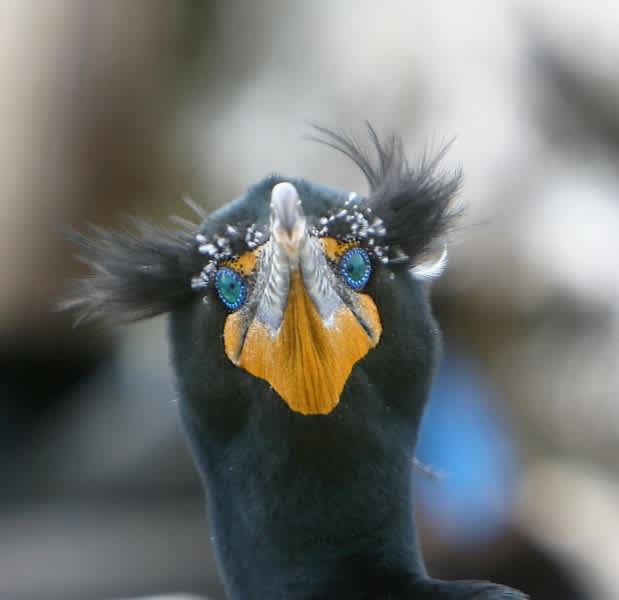I Hate Cormorants
K.J. Houtman 09.30.13


Those gangly, gluttonous rats with wings—I want cormorants on my lake as much as I want rats in my house. I can only imagine during creation that God (perhaps distracted by the profound beauty of the new little hummingbirds) oopsed on the cormorant. An angel likely suggested a mulligan, and that is how we have the beautiful Common Loon.
Anyway, I’m not alone in my dislike. In fact, I would challenge you to find anyone who does like cormorants. So why the heck were they included in an amendment to the Migratory Bird Act as a protected species in 1972? Perhaps another oops, only this one by a well-meaning group of conservationists hoping to protect all the birds that migrate between Canada, the United States, and Mexico.
Blah!
To think that people confuse loons with cormorants blows my mind. I love loons. They both dive for fish, yes. Their silhouette and diving patterns on the water can seem…well…somewhat similar from a distance. That’s where it ends.
The loon has several beautiful calls: the endearing tremolo, the haunting wail, the distinct yodel, and the simple hoot. The cormorant has nothing of value in their song, only a hiss or a grunt; no beautiful sound to add to our natural setting. The young in the nest are shrill in their high-pitched whine for food.
When I drink my coffee on the deck in the morning and hear the call of the loon, I feel blessed. It is part of why I live in the Northland, graced to share space with these beautiful birds. What a treat to see the loon dive and hear the call.
When I see the cormorants dive for fish 30 feet off the end of the dock, I run, clamping loudly on the wooden dock sections and holler “shoo-shoo.” They ignore me.
Is it fair? Double standard? I don’t care; it is what it is. Double-crested cormorants, aka Phalacrocorax auritus, I don’t like you.
This bird’s meat is not even on the radar for human consumption. No one in North America hunts them, at least not for food. A few have hunted them (legally and illegally) to preserve their fishery. They are synonymous in literature with evil or a dark force. An award-winning novel titled The Cormorant, by Stephen Gregory, presents a satanic persona for the bird, who wreaks havoc to the main character’s cat and son. Cormorants are called “unclean” in the Bible and, in Milton’s Paradise Lost, Satan is “like a cormorant” sitting on the Tree of Life. I learned all these cormorant factoids from an interesting article by Dr. Richard J. King. Maybe King likes cormorants; he sure has studied them. In fact, he has a new book coming out in just a few days (in October) if you’d like to read more: The Devil’s Cormorant: A Natural History, published by University of New Hampshire Press. It’s available here and at Amazon.

Gluttonous rats with wings. Folklore had me believing that a cormorant eats many more fish per day than other birds. A reality check (to write this article) led me to find out they actually eat less fish per day than a Common Loon. I thought I was completely justified hating these infamous characters for their ravenous appetite. So why do we hate them?
“It is a perceived competition for fish that dates back to the European settlement era of the 1800s,” shared Douglas Schultz, Walker Area Fisheries Supervisor of the Minnesota Department of Natural Resources. “When you live in a tourism-based economy, these things have an impact.”
“We did a lot of work, completing an environmental impact study and performing research for years before we moved forward to strategically reduce the cormorant population,” said Schultz. The DNR folks in the Leech Lake area started culling the cormorant population in 2005, eliminating as many as 3,000 birds per annum in the first years of the program. This year they only killed 400 birds as the population is much more in check. Does that mean we now have a balance that the public likes their cormorants? “Well, tolerates is a better word,” replied Schultz wryly. “I still get calls that people think there are too many.”
Minnesota isn’t the only place that has had an all-out effort to reduce the cormorant population. New York residents were incredibly frustrated with the bulging cormorant population in the eastern basin of Lake Ontario a few years back. Vigilante outdoorsmen thinned the population without the benefit of environmental impact studies and sans partnership with the DEC in New York State. They later turned themselves in.
Several charter boat captains and a few folks with businesses ties to lake-based tourism received fines. “The government groups moved too slowly and the locals supported the work those few guys did, even if they were penalized,” said Fred Kucik, charter boat captain of Shady Lady Charters out of Henderson Harbor/Sackets Harbor, New York when asked about the illegal cormorant shootings a few years ago. “We had a big fundraiser to help pay their fines. The locals supported what they did. Something needed to change and quickly.”
State and federal agencies have sped up procedures to react to areas with escalating cormorant populations. Good thing, too. I can’t condone taking the law into your own hands to solve a problem, but I can understand their motivation to do so when State and Federal agencies move too slowly.
K.J. Houtman is the author of the award-winning Fish On Kids Books series, chapter books for eight- to 12-year-olds with adventures based around fishing, camping, and hunting. Her work is available at Amazon and local bookstores. Find out more at fishonkidsbooks.com.

